First published: April 2020. Most recent change: December 2020.
In public transport, face masks (often called “mondkapjes" in Dutch) are mandatory. This is a relief for the transportation carriers, who find masks much more sensible than an impossible 1.5 meter distance between passengers. But for months now, the government has been treating mouth coverings as false security. And to this day, many care workers work without proper protective materials. Why did RIVM deny the need for masks of thousands of caregivers, while people were advised to wear them on public transport? Why is almost all of Europe wearing a mask, but not us?
An in-depth analysis, which we are constantly updating with new insights and evidence
The conclusions:
- Widespread mask-wearing in public, especially in indoor spaces, greatly slows the epidemic.
- If everyone wears a mask over their mouth and nose in private, the risk of infection is very low to zero.
- Medical mouth masks provide excellent protection for people in risk groups (please wear glasses too). Ordinary masks provide some protection for other groups, even if you are the only one in the room.
The assertion that masks offer total protection
This dossier argues that masks slow down the epidemic and provide reasonable to excellent protection against infection. But in recent months, a new and groundbreaking conclusion has emerged: masks protect almost completely when everyone wears them. Even if you stay in an indoor space for a long time, even with only moderate ventilation, and even if your social distancing is limited. The indications for this include:
- In a Missouri hair salon, no one became infected by two contagious hairdressers (see below).
- Millions of flights with passengers wearing masks, high virus circulation among tourists, and frequent testing in many countries have not led to media reports of transmission.
- There are no known instances of transmission in Dutch public transport, despite the fact that the air is recirculated without HEPA filters.
- Masks prevent almost all droplets from spreading.
- This Covid doctor, who is “terrified” of the disease, finds the 1.5 m distance completely insufficient without masks.
Anyone who believes this conclusion will realize that cinemas, hair salons, schools, and offices can actually open without restrictions as long as people wear masks. This offers enormous opportunity to ease inconvenient social distancing and cleaning measures.
Background

"Mondkapjesgate" (“Maskgate”) started when many people in high-risk professions had to work with little to no protective equipment. With a troublesome mortality rate amongst elderly people in nursing homes, the Cabinet promised rapid improvement. Almost 4 months later, care workers are still working without masks. It is also hard to understand why masks are required for ordinary citizens on buses (while at the same time the burka ban prohibits them), but they are discouraged as “false security” in the cinema and barbershop. The whole world wears masks, and they can't believe it when they hear that Dutch hospitals, hairdressers, and cinemas are virtually mask-free. And they are right.
Strange government reasoning
The government’s reasoning is often hard to pin down. If, according to RIVM, masks are of limited use, why do people wear masks in all countries where the epidemic has been largely contained? And why did research conducted by our own RIVM in 2009 prove that masks, and even tea towels, play a decisive role in extinguishing an epidemic? Healthcare workers prefer to wear masks, mainly to protect their already weaker patients, but also to protect themselves. According to RIVM, masks pose a risk if used incorrectly, but this confuses complicated FFP2 mouth masks (for Covid doctors) with ordinary surgical masks for healthcare personnel and regular citizens. At the bottom you will find links to articles that convincingly prove that masks are an important weapon, both to protect yourself, to protect others in the neighborhood, and to slow the pandemic.
Don't be confused by ‘you are not protected in situation X’. It is about slowing down the pandemic.
There is said to be a shortage of masks on the world market, but manufacturers and traders refute this. Masks are freely available online and are distributed in many countries for free or at cost, even to ordinary citizens. Minister van Rijn spoke on 28 April of a shortage of transport capacity from China, but a single Boeing 747 can carry millions of masks. And Ann Vossen of the government's Outbreak Management Team suddenly claimed that the guidelines, which still state that it is possible to work without protective equipment in several care professions and situations, have nothing to do with shortages.
People's concerns that masks reduce their oxygen supply are unfounded. mouth masks with a filter can make breathing slightly more difficult, but are not unhealthy for healthy people.
Why are masks so useful?
Masks do 4 things (more detail in the table below):
- Protect the wearer by filtering the air, so fewer or no virus particles enter the respiratory tract and the wearer stays healthy. This happens with an FFP2/3 respirator/mouth mask.
- Protecting others in the neighborhood. By keeping your “own” dirty air with you, fewer or no virus particles make it to the people around you. Surgical masks are ideal for this.
- Slowing down the pandemic. Epidemiology is about statistics, and even if you stop only 10% of the virus particles between person A and B, it will have a noticeable effect on the population’s infection rate. To this end, any facial covering helps.
- Make the mask-wearer and others aware of the risk of the virus, and thus help to adjust their behavior.
Beware! A medical mask or work mask with a valve protects the wearer, but not the environment. The valve simply allows the outgoing air to escape. These are suitable for Covid doctors, because they don’t need to worry about infecting their patients, but they are not suitable for civilians in public transport or for hairdressers.
What is the proof?
There is abundant evidence that masks work, are important in this pandemic, and can even be the decisive factor. This evidence includes:

- Evidence that masks in laboratories stop virus particles — there is no doubt about this.
- Evidence that masks in labs and simulations lead to less infection and disease — this is very plausible.
- Empirical evidence from observation and experience.
The first is simple: virus particles rarely pass through a good mask, if it fits properly.
Regarding the second point, it is Jacco Wallinga (!) with Aura Timen (!) at the RIVM (!) who already convincingly demonstrated in 2010 that masks can slow down an epidemic, even without any other protective measures. Airborne viruses, such as Corona, can be inhibited even more. There is also this meta-analysis that puts the debate to rest: masks work and are a very important intervention. About 65% safer, for example. Even the Swedish Karolinska Institute says that the value of masks is not in question.

As for the third category — empirical evidence from observation and experience — there is actually an abundance of evidence. Countries that use masks are much less affected by the virus.
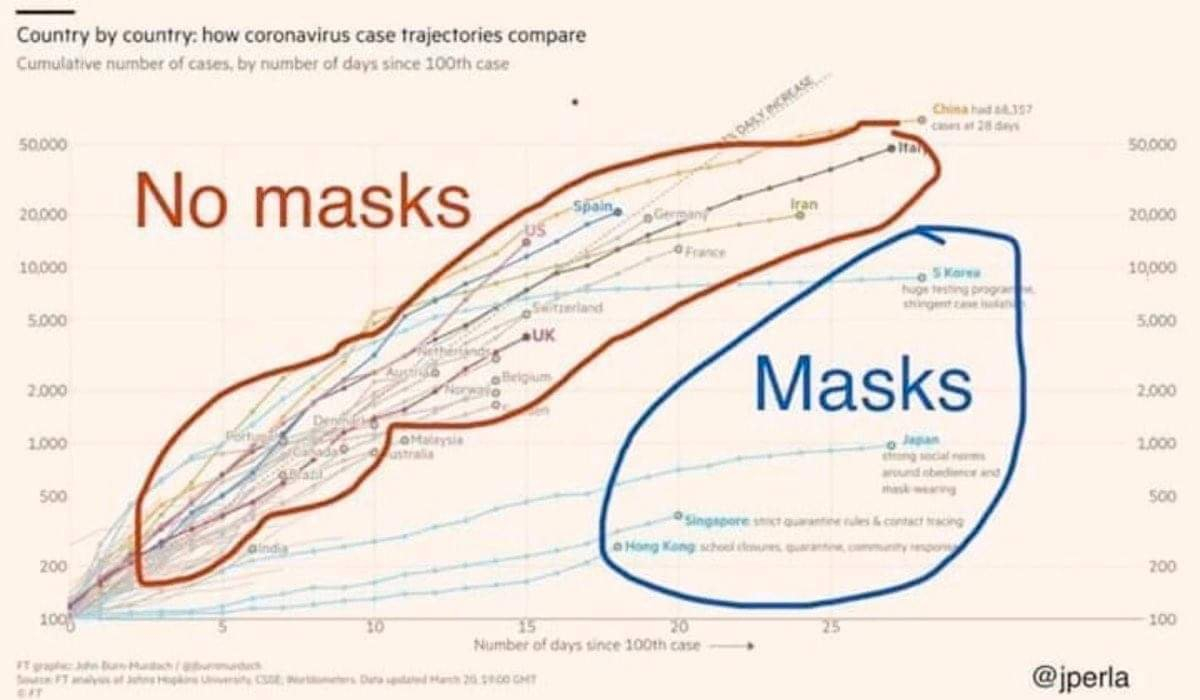
In a hair salon in Missouri, two infectious hairdressers treated 139 customers for weeks, and not one of them got Covid. As mathematician Nassim Taleb pointed out, that's more than merely an indication that masks help in such situations, it's evidence.
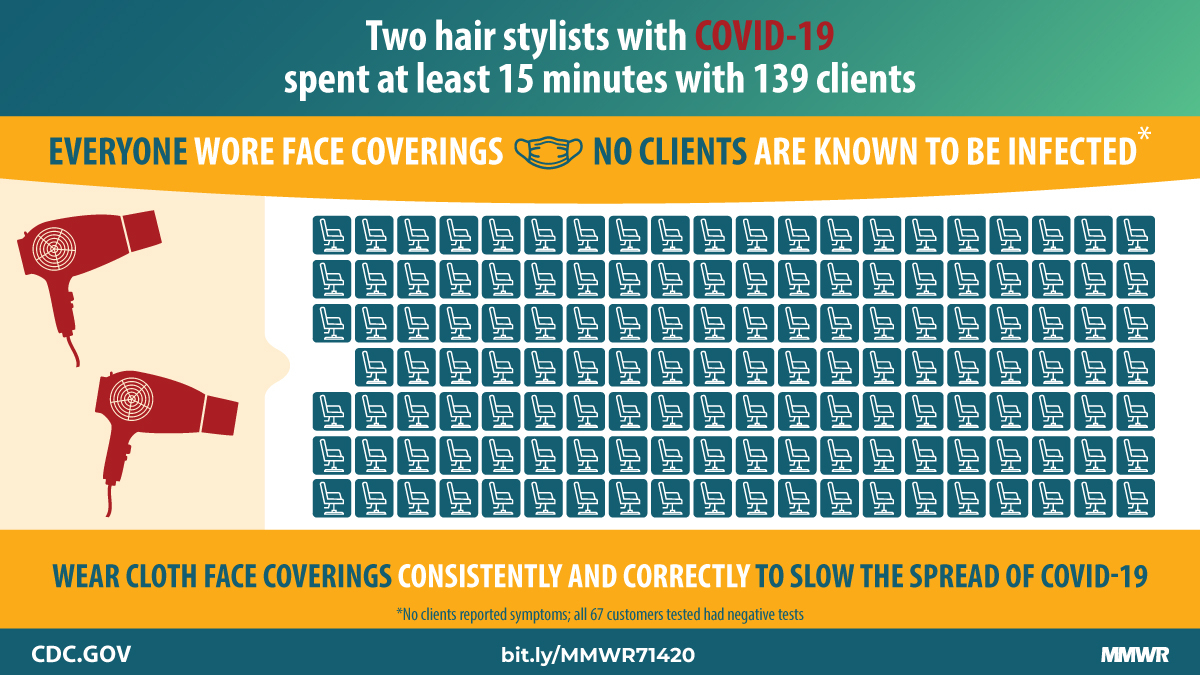
And The Economist also contributes. Masks are worn in places where the virus is under control, increasingly in places where it is not under control, and much less in the Netherlands and Sweden (the OECD countries with the governments that least want to fight the virus). Denmark was able to keep virus rates very low in the spring with a strict lockdown and excellent test-trace-isolate.
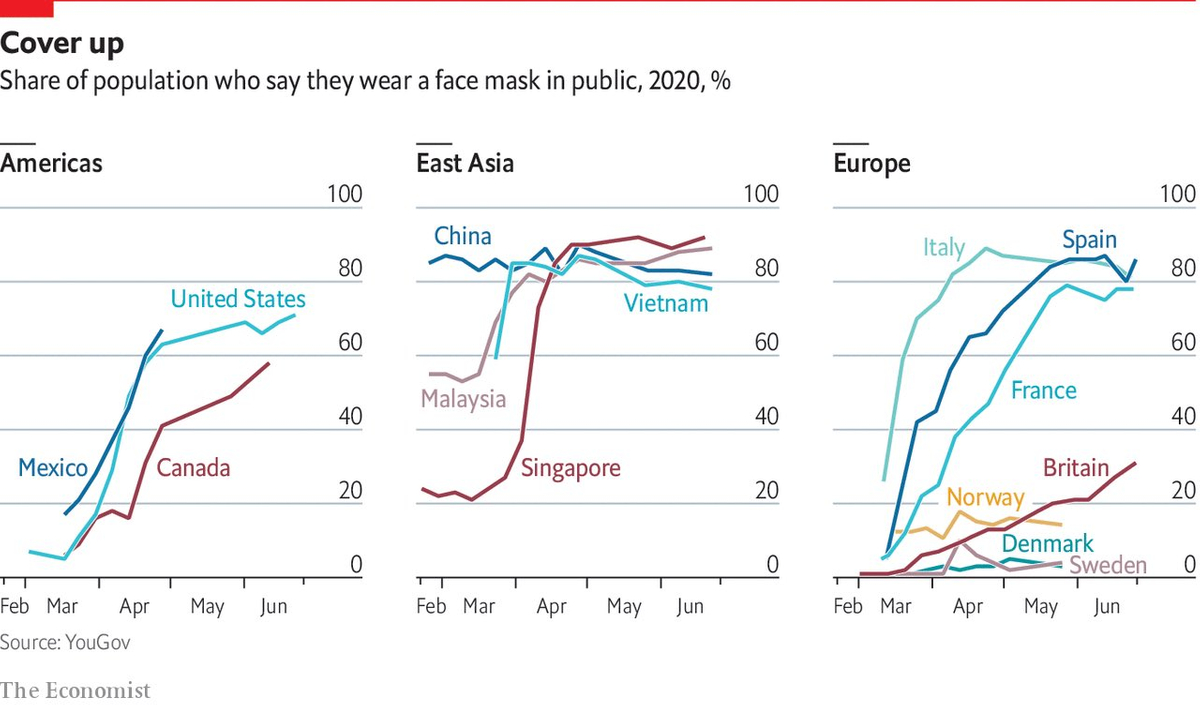
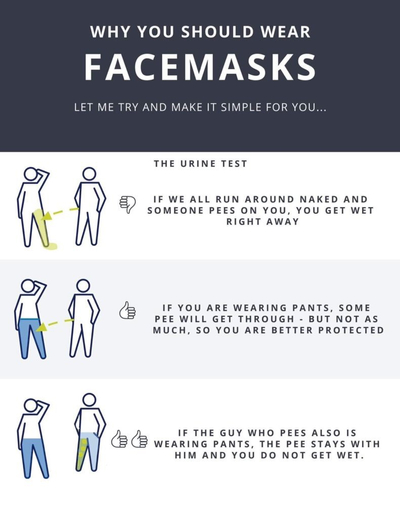
Then there is your own common sense. You're in a room with other people who might be contagious, but with Corona you often don't notice that, especially if they are not coughing or sniffing. The people send out virus particles in their exhaled breath. Rather than going directly to you, do you want that air to stay with the infectious person, be partly distributed throughout the room, and partly remain on a mask? Yes, that's what you want.
Then why don't we wear them?
Six months of uncertainty, anger, and confusion about face masks. Maybe the explanation is very simple. It stems from the Cabinet's strategy in this pandemic: with "maximum control", the Cabinet does not want to contain the virus as much as most countries want to or already do. The goal in the Netherlands is to let normal life continue as much as possible without overburdening the hospitals. If the hospitals threaten to become overburdened, the government puts the brakes on (hairdressers and restaurants are closed), and when hospitals have more room, the brakes are gently released again.
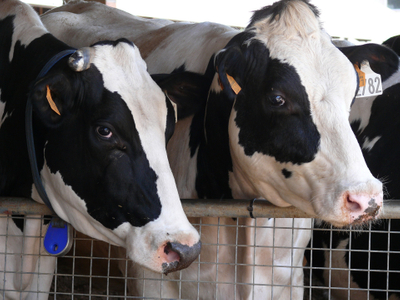
- This policy assumes that a large part of the population will be infected with the virus until a vaccine is available or the epidemic is extinguished with "herd immunity" (a veterinary medicine concept in which cost-related decisions must be made about cows). And then it immediately becomes clear why face masks do not have a very high priority for the Cabinet. Offering protection for a year or more to a care worker who is likely to become infected through frequent contact with other people is not a wise use of public money. The costs per employee are not that high, but for the entire system you're talking about hundreds of millions of euros. Working without protection may make sense economically, but the average nurse or homecare professional won't feel that way.
- The government also continues to think that contamination by airborne particles (and not just droplets) contribute only minimally to the epidemic. In that case, social distancing would be enough.
False security, or the attack on logic and credibility
Are masks on citizens false security? No, the government’s 1.5 m measure is false security
To this day (July 2020), RIVM and OMT members stand by the argument that masks negate other measures, assuming masks cause people to stand closer to each other. There is not a shred of evidence for this. On the contrary, anecdotal evidence and research show that masks make you more observant, that others respect you more, and that general awareness of the risks increases.
And if a safety measure makes you likely to take more risks, why do we still have seatbelts in cars, helmets on motorcyclists, and crash barriers along the highway?
And there is the problem of the 1.5 m rule, which is often impossible to respect and is decreasingly obeyed. It seems that false security comes from the government’s 1.5 m measure instead.
A summary of the authorities’ fallacies can be found in this piece by Jaap Stronks.
In the last week of July the rationale against masks spread quickly, and it was all rather questionable:
- “A mask requirement is legally unachievable.” But then is the 1.5 m rule also unachievable? No, because it is regulated by emergency ordinances that are not intended for long-term deployment. If this is the argument, the Cabinet could also enter into discussions with cinemas, stores, and hairdressers to prohibit it under private entrepreneurship law.
- "Masks are stressful and make you sick.”
- “Infections occur mainly at home.” We call this the “van de melkboer” (“from the milkman”) argument. If you don't do a lot of testing, do poor contact tracing, and do bad research, it may appear that infections come from family members. But of course the epidemic is driven by infections in public places: hospitals, churches, schools, fitness centers, etc.
The 1.5 meter rule: a good idea?
In the Netherlands, there’s really just one control measure: keep 1.5 m distance everywhere except with your own family. Is that enough? No.
What’s preferable: masks indoors and in crowded places, plus 1.5 m wherever possible and a requirement to keep your distance outside.
- People do not want to keep a distance, so the measure automatically has a diminishing effect. Everyone can see this with their own eyes in July 2020.
- 1.5 m is often not possible. This is true in stores, hair salons, offices, and many other places.
- The 1.5 m rule is not enforceable, because no one can stick with it and many people don’t want to do it, compliance only lasts for a while, and police are not everywhere. Just wear masks. It becomes automatic. If you don't wear one, other people will quickly know.
- A 1.5 m distance does not protect you well indoors, because the virus floats around in the air.
This is not to say that keeping a distance doesn’t help. But it is plausible that masks are more important. Wearing masks indoors, plus keeping a distance whenever possible, would be a helpful rule. Outside, keeping a reasonable distance is enough, except in crowded places. That is easy to remember and is more sustainable. See how Japan does it.
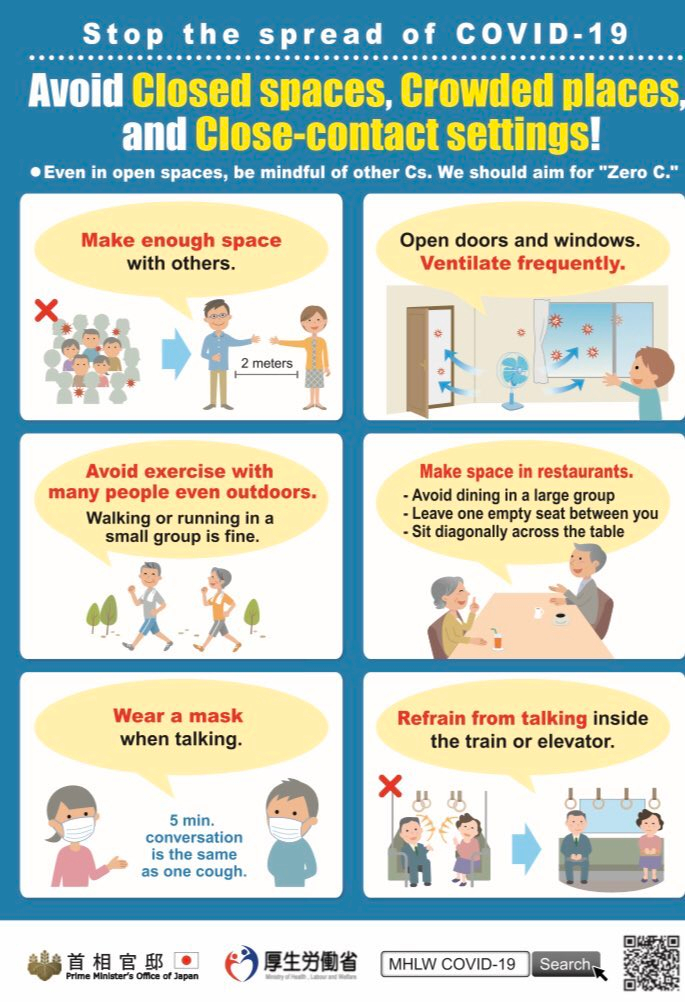
The snake in the grass
There was also a “snake” in Premier Mark Rutte's speech on 16 March. When he talked about “herd immunity” as a policy goal and about “building a wall around the vulnerable,” he implied that it would be desirable for children (who are less likely to get sick from Covid) and care workers to become immune as soon as possible. In the case of care workers, immunity would be desirable because of their contact with sick and therefore vulnerable patients. You don't achieve that immunity by protecting them against the virus. Hopefully that was not a conscious objective, but it is a logical consequence of what Rutte said and may play a role, perhaps subconsciously, in the lack of a push for masks.
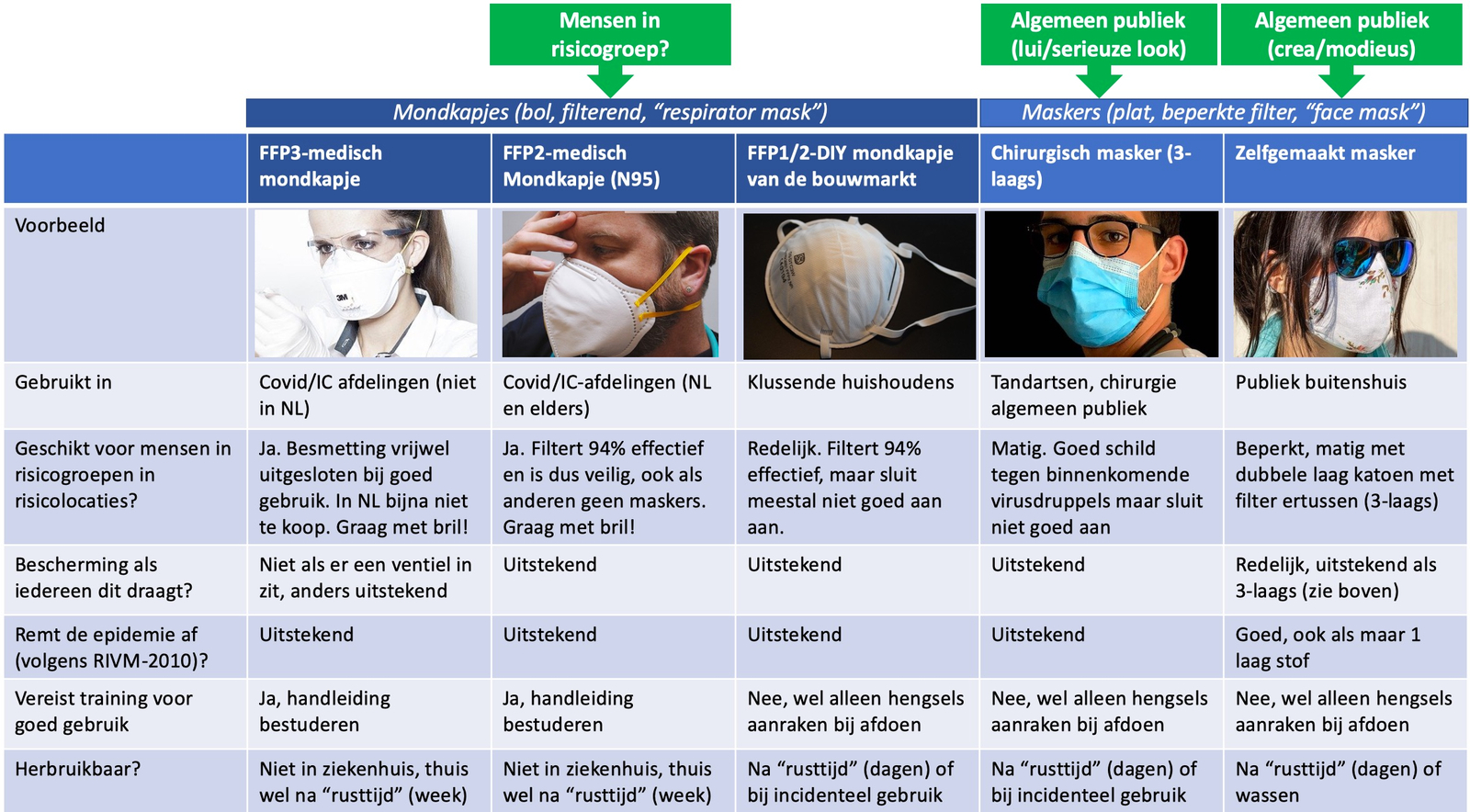
Updates
The assertion by Jaap van Dissel that Norwegian research supposedly proved that masks only have a marginal effect, was quickly debunked. The research dealt with a situation of low virus prevalence (not in The Netherlands) It was also a pre-print, not-yet-peer-reviewed research, which did not lead to clear conclusions. Its author even stated that the study did not allow for conclusions to be drawn for The Netherlands, and that masks in fact do reduce the spread of the virus.
Useful links
https://www.medrxiv.org/content/10.1101/2020.04.03.20051649v3
https://www.thelancet.com/journals/lancet/article/PIIS0140-6736(20)31142-9/fulltext
https://www.livescience.com/hair-stylists-infected-covid19-face-masks.html
https://onlinelibrary.wiley.com/doi/full/10.1111/j.1539-6924.2010.01428.x
https://www.medrxiv.org/content/10.1101/2020.07.13.20041632v1
https://www.weforum.org/agenda/2020/07/experts-a-mask-cuts-your-coronavirus-risk-by-65/
Mick Blok is an entrepreneur and a human rights activist.